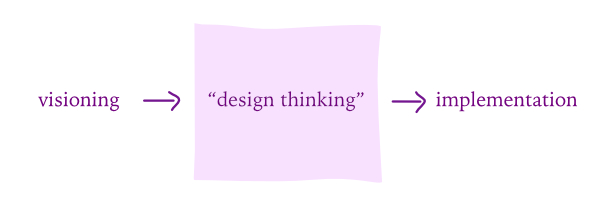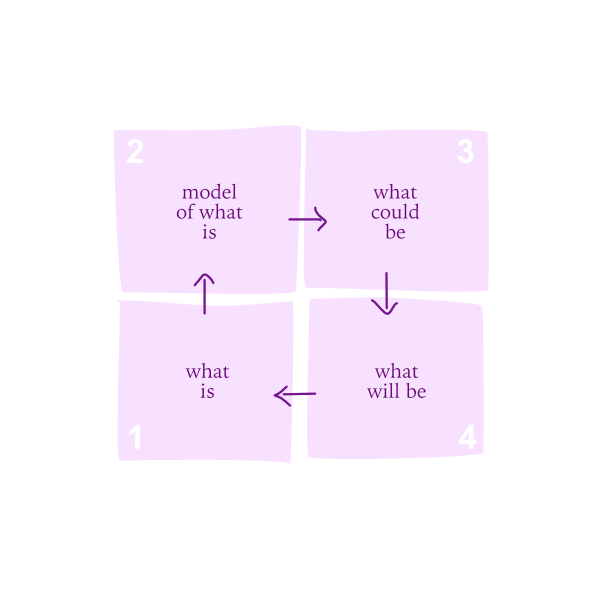Design Thinking Methodology
Design Strategy | Service Design | User-Centered Research
My Methodology
Making something new can be difficult, especially working at the level of an organization, or when working on a complex service. Helpfully, there methods that can be used to organize the complexity and improve the odds of project success.

Any project must begin with a clear statment of the goals. There will be a team, and that team need be aligned. Also, from the beginning, the end of the project must be prepared. How will the outcomes of the project be implemented? Sandwiched between is "design thinking." In my implementation, the "4-square model."

The 4-square model is a process of getting to a future state by detouring through an abstracted state. In four easy steps!
1. What Is
This is the the current state of affairs. The real-world, concrete, actual thing we have decided to improve. For example, the current service. It is impossible to describe, since any description of it is a model, but I'm getting philosophical now, so let's continue…
Tools: Secondary research, Internal expert interviews, Market-/Business- analysis, Primary research, User-centered ethnographic interviewing, Remote interviewing, Surveys …
2. Model of What Is
Once we have researched the existing state, we model it. We create an abstracted model. It is no longer true, but simplified, and thus easier to think about and communicate.
Tools: Mode-, Values-, Ecosystem- Models, Journey Map, Painpoints, Personas, really any map…
3. What Could Be
Now we take our map, and think hard about how we could change it for the better. We make a model of a new, improved state.
Tools: Workshopping, Role-playing, Gamestorming, Service Blueprint, Prototyping …
4. What Will Be (Made)
Finally we make it real. How, pray tell, can we get from our new and better model to a new a better real thing?
Tools: Creating of boundary objects for communication, Spectacular presentations, Video razzle-dazzle, Implementation planning, Elbow grease, …
Design Methods-slash-Frameworks that I use
RESEARCH
Expert interview
Trends research
2x2
Offering map
Manifesto
Planning survey
5 factors (physical, cognitive, social, cultural and emotional)
POEMS framework (people, objects, environment, messages and services)
Field observation
Shadowing
Interview
- boundary object (pictures, cultural artifact, image sorting, user journey)
Prototype testing
FRAME
Observations to insights
Sorting
ERAF (Entities, relationships, attributes and features)
Design Principles
Value statement
Quad A
5E's
XMOD
Value web
User Journey
Painpoints
People Models
Journey Models:
- life story - journey - day-in-the-life - scenario - moment - task
Modal Models
Values Models
Ecosystem Models
NEW PRODUCT DEFINITION
Value hypothesis
Persona
Concept metaphors
Role-play
Paper prototype
Figma